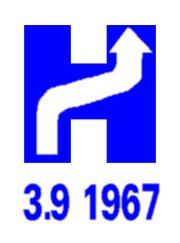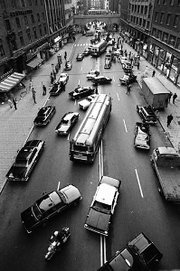Dagen H
|
|
Dagen H (H day) was Sunday, September 3, 1967, at 5:00 a.m., in Sweden. It was the time traffic switched from the left-hand side of the road to the right. The H stands for Högertrafik, the Swedish word for "right-hand traffic".
The arguments for the change were clear.
- All Sweden's immediate neighbours drove on the right (including Norway, with which Sweden has a long land border).
- Most Swedes drove left-hand drive (LHD) vehicles. This led to many head-on collisions when passing on two-lane highways, which are common in Sweden because of its low population density and traffic levels.
Nonetheless, the change was unpopular with the people. It had repeatedly been voted down over the previous 40 years. In a 1955 referendum, 85 per cent voted to keep driving on the left. In 1963, the Riksdag (the swedish parliament) approved the changeover and established the Statens Högertrafikkomission (HTK), or 'state right-hand traffic commission' to oversee it. It also began implementing a four year education programme, with the advice of psychologists.
As Dagen H neared, every intersection was equipped with an extra set of poles and traffic signals wrapped in black plastic. Workmen roamed the streets on Dagen H to remove the plastic. Similarly, a parallel set of lines were painted onto the roads with white paint, then covered with black tape. Before Dagen H, Swedish roads used yellow lines.
All non-essential traffic was banned from the roads from 1:00 am to 6:00 am on Dagen H. In Stockholm, this ban was extended to allow work crews to reconfigure intersections. It ran from Saturday at 10:00 am to Sunday at 3:00 pm. Any vehicles on the roads during that time had to follow special rules. All vehicles had to come to a complete stop at 4:50 am, and change to the right side of the road. At 5:00 am, they were to resume.
One way streets presented unique problems. Bus stops had to be constructed on the other side of the street. Intersections had to be reshaped to allow traffic to merge.
Trams were withdrawn, and replaced by buses, and over one thousand new buses were purchased with doors on the right-hand side. Some 8,000 older buses were retrofitted to provide doors on both sides. Every Swedish car needed to be modified, even LHD models, since they had to have their headlights readjusted. When dipped, headlights are directed slightly to the side of the road, to prevent blinding oncoming drivers, and cars had to be adjusted so that their lights dipped to the right instead of to the left.
On the Monday following Dagen H, there were 125 reported traffic accidents, compared with a range of 130 to 198 for previous Mondays. No fatal traffic accidents were attributed to the switch. However, many older people gave up driving rather than learn to cope with the new rule of the road. Experts had suggested that changing to driving on the right would reduce accidents, because drivers would have a better view of the road ahead. Indeed, fatal car-to-car and car-to-pedestrian accidents dropped sharply as a result.
The Swedes had a history of switching conventions. In 1712, they had a February 30, so that the Swedish Calendar could be in sync with the Julian calendar.
Memorabilia
The Dagen H logo was used on various commemorative items, including women's underwear.
See also
de:Dagen H he:דאגן H pl:Dagen H ru:День H sv:Högertrafikomläggningen



